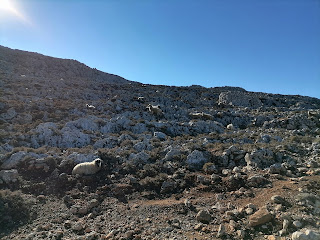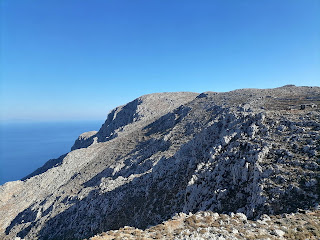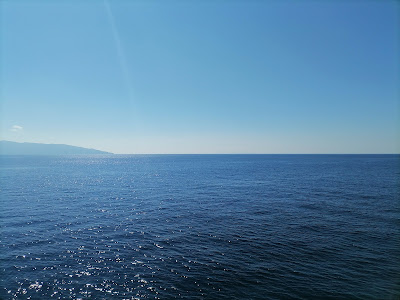The peak of the hill above Halki’s abandoned village isn’t merely a medieval castle. Like the one above Megalo Horio on Tilos, this area was in ancient times - several centuries before Christ - an acropolis. It was exhilarating to wake up within its walls.
The only sounds were the humming engines of fishing caiques
around the shores of Tracheia three hundred metres below, and a pair of birds
again clackety-clacking and peep-peep-peeping to one another nearby. The sheer
slopes below had the outlines of fields.
My head still full of strange dreams of people coming and going, I
wanted to soak up the atmosphere, but had to pack up early in case anyone
arrived. Then we heard distant gunshots: I didn’t know there was hunting on Halki.
Lisa sought sanctuary inside the tent that was still wet with the damp of the
night, abandoning ideas of breakfast or water. So much for lightening the load.
I stuffed everything back into the pack and eventually coaxed her out.
Leaving no trace and taking only memories, we walked out to a spectacular view as the early sunlight turned the mountains amber, while in the shadows the rock remained grey. I could understand why the ancients carved thrones for the gods Zeus and Hecate here.
On the way down through the ruins of the village, I paused to look at the stone-built houses, a mixture of huge masonry blocks and careful stonework with bits of glazed pottery stuck in the plaster, almost all with their own sterna, a cistern for retaining rainwater. Goats and sheep wandered freely, and in the distance I heard a pickup truck heading up the road.
At the road, by a threshing circle I looked inside some of the kyfes, the old, stone-built shepherds’ huts. The outer walls were of smallish rocks, but inside they were massive, rough slabs of rock yet stacked and interlocking so intricately as they gradually arced up into a domed roof.
It was about eight thirty and already hot by then, and I still
wasn’t sure exactly how far I would go. A team of men from the electricity company
were replacing the wooden poles and the cables. As I set off uphill, an old man
with a long beard rode past on a donkey, sitting sideways on a wooden saddle; I’d
passed him the previous evening and wordlessly he’d indicated I should hold on firmly to my dog. A younger man rode by on a
little motorbike; it looked like the man who’d told me to take the road slowly.
Further up the road, I looked down and saw him feeding pigs and chickens in sheds
made from reclaimed wood and doors and windows.
If it sounds busy, it wasn’t. For most of the way, it was very
still and quiet, with partridges and goat bells, and the occasional gunshot far
in the distance. I’ve walked this way a few times in different seasons and each
time see a little more – the wonderful circular enclosures everywhere, most
with a fig tree growing in the middle (for shade and food?). The sea was a silver shimmer back east towards Rhodes, a pale blue
expanse south to the abandoned island of Saria very clear on the horizon.
It was good to have distractions. As the day warmed up a
little and I was still carrying most of the food and water I’d brought, the
road would rise about two hundred and fifty metres over a couple of kilometres.
Already, when I looked back, the castle seemed far below. The road seemed tough
and long, carved into the side of the mountain with
nowhere comfortable to stop, so I’d keep going to the bend at the top. And
there, I was excited to see the ruined windmill already – we’d reached the plateau and the road would level out. So I was already about
halfway across the island – why I’d wanted to camp at the castle. Maybe I could
keep going a while.
I looked out across the stony flat upland, so dry at this time of year, just an expanse of rocks, some of them piled into walls around fields, some piled into kyfes that were barely distinguishable except for the dark mouths of the doorways. I always find it a mysterious landscape – it feels like happening upon another world where people live in holes in the rocks.
Somewhere beyond the slopes to either side were the highest
peaks of the island, according to my map, Profitis Ilias at 578 metres and
Meroigli at 600. Across the dry plateau was the start of the steep path down the
gorge to Ai Georgi tou Riakiou (I mistakenly called it Ai Yianni in my book, I now realised), where I’d arrived scarily dehydrated one May day and been extremely
thankful to find water in an old cistern. I stashed a bottle of water and a tin
of dog food in the windmill to pick up on the way back, and set off again on
the gentle road west.
After a bend or two in the road with spectacular views down steep inclines and cliffs to the north coast, the land opens out again into another old agricultural area known as the ‘gardens’ with cisterns scattered everywhere according to the map – an area to explore another time – the monastery of Ai Yianni o Alarga, St John the Far-Away, was in sight.
The area beyond was what I wanted to explore – an old settlement with the church of Agia Pelagia and some kind of a beach. We stopped briefly for a drink of water and a handful of food at the
monastery gates, where I noticed a sign: ‘Hunters are asked to please leave their
dogs far away from the gate. Welcome.’
Last time here, we’d failed to find the start of the path, but
this time I followed the instructions on the map and found it around the back
of the monastery. From here, I knew I wouldn’t go far today. The paths weren’t
clear enough. I still had enough
food and water, but if I went all the way down to shore, I’d have to camp again
to have enough energy to get back to town again. Doing that alone, when already
tired, would be getting into a risky zone. And by now, Dioni had responded
saying the apartment on the harbour was waiting for me.
But it was a joy simply exploring for a while, getting a sense
of the dramatic and wild terrain, feeling the exhilaration of being alone at
the empty end of the island. There were little pink flowers growing between the
rocks, and eagles soared overhead. Every now and then, I’d come across a cairn demarcating
a path, but they blended in so well with the rocky terrain, as did so many of
the buildings that should have been landmarks, and were probably mostly knocked
over by goats.
Following the hillside around to the north, I finally saw a chapel way below – Chrousi? That was probably the way I’d explore next time. We descended to one group of ruined stone huts – Vokolia? Heading south, we reached the sheer ridge where, according to the map, gaps through the rocks led to more ruins – so much to see. Too much for me today. Sometimes just looking for Agia Pelagia is enough.
I made my way back up to the monastery, where the team from the electricity company were replacing the colones. The olive trees and cypresses were well watered at the monastery, and it was amazing to imagine what these uplands might have looked like when all the gardens were watered from the cisterns. Now it was so dry. Sheep wandered everywhere – what did they survive on?
It was a lovely walk back, eating and drinking as much as
possible, though I still felt a little wistful to be heading back to
civilisation. A taxi driver waved, taking a couple to the monastery. I stopped
and put down my bag to walk up to what looked as though it could be a chapel,
and found what I think was Ayios Lavrentios.
At the windmill, I saw a kestrel with a reddish-brown body and grey wings, and a flock of falcons were crying and circling high up. Finally Lisa decided to eat something. It was all downhill from here, and by four in the afternoon, we were back at Ftenagia for a swim.
























































